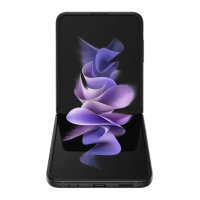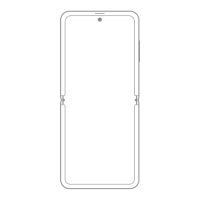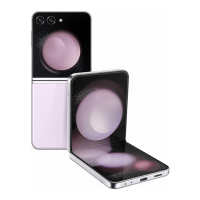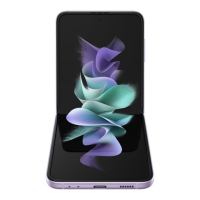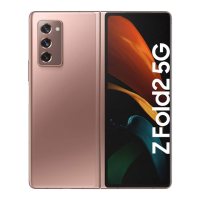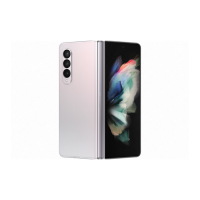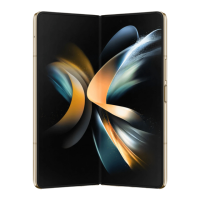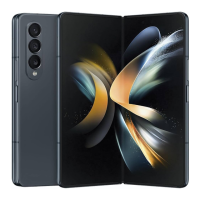Do you have a question about the Samsung Galaxy Z Flip4 and is the answer not in the manual?
How to wirelessly transfer data from an Android phone using Smart Switch.
Setting up and customizing screen lock types and notification display on the lock screen.
How to make calls using the keypad, recents, or contacts.
Options to answer, decline, or end calls, including declining with a message.
Steps to activate Emergency mode to access essential functions during emergencies.
Making emergency calls from the lock screen or without service or SIM card.
Details on charging compatibility with USB-C chargers and previous Galaxy devices.
Tips for optimizing battery charging and preventing overheating.
Steps to power on, power off, and restart the device using the Side key.
How to wirelessly transfer data from an Android phone using Smart Switch.
Instructions for transferring data from an iOS phone to a Galaxy device using iCloud.
Instructions for data transfer using a USB cable and OTG adapter.
Guide to transferring data using a microSD card or USB flash drive.
How to remap the Side key for double press or press and hold actions to open apps or Bixby.
Restricting child's app usage and setting content restrictions via Google Family Link.
Controlling sounds and vibrations for notifications, screen touches, and other interactions.
Customizing lock screen notification settings, including style, transparency, and content hiding.
Choosing from various shooting modes like Single take, Photo, Video, Pro, and Panorama.
Configuring camera settings like scene optimizer, shot suggestions, and QR code scanning.
Capturing multiple photos and video clips with AI, including editing options.
Recording and editing 8K videos using the Camera app and Editor.
Viewing and editing photos and videos, searching, grouping similar images, and accessing options.
Taking screenshots using button combinations, palm swipe, voice commands, S Pen, or Edge panel.
Recording the device screen, optionally with front camera, and accessing screen recorder settings.
Managing files on the device, including moving, copying, and deleting files and folders.
Basic navigation within the Samsung Internet app, including top and bottom toolbars.
Accessing and creating custom routines to automate tasks based on triggers and actions.
Using Bixby Vision with the camera for information, translation, and scene description.
Organizing notes with categories, search, quick highlight, and action icons for efficient note-taking.
Using Samsung Pay for streamlined payment processes, exclusive deals, and managing cards.
Setting up the SmartThings app to connect and control smart devices, organize rooms, and create scenes.
Connecting to a Wi-Fi network, scanning for networks, and adding networks manually.
Pairing devices, renaming paired devices, and unpairing from Bluetooth devices.
Making payments using NFC technology with a payment app and compatible credit card reader.
Checking current mobile and Wi-Fi data usage, customizing data warnings, and turning on Data saver.
Managing SIM and eSIM, including activation instructions and inserting the SIM card.
Setting up face recognition, fingerprints, Google Play Protect, security updates, and Find My Mobile.
Setting up and using facial recognition for unlocking the phone and verifying apps.
Setting up and using fingerprint recognition to unlock the phone and verify apps.
Locating missing devices, remotely locking/unlocking, and setting up a Guardian for device access.
Keeping apps and accounts secure by authenticating identity with biometric data.
Creating a secure, encrypted space for private information using Samsung Knox.
Connecting to public or unsecured networks securely using Secure Wi-Fi.
Setting up a basic phone lock screen using password, PIN, or Pattern, and biometric security.
Setting up biometric security for unlocking the phone with face, fingerprints, or iris.
Configuring secure lock settings like auto lock, lock instantly with Side key, and auto factory reset.
Dictating app permissions and customizing advertising content within apps.
Setting up and using facial recognition for unlocking the phone and verifying apps.
Finding the fingerprint scanner location and registering fingerprints for security.
Registering fingerprints and configuring fingerprint unlock settings.
Setting up Samsung Pass for biometric authentication and autofill services.
Turning on remote controls and remote unlock, and setting up a Guardian for device access.
Adding Samsung, Google, and email accounts to the device for service access and synchronization.
Backing up and restoring data using Samsung Cloud, Google Drive, or microSD cards.
Enabling automatic backups to Samsung Cloud for data protection.
Restoring data from Samsung Cloud backups to the current or another device.
Backing up and restoring data using a Google account for syncing across multiple devices.
Backing up files to a microSD card using the My Files app for offline storage.
Managing Google services settings like ads, autofill, backup, and parental controls.
Setting up and managing a Samsung account on phone, tablet, or computer for exclusive features.
Steps to add, sign in, manage, and edit Samsung account information on a device.
Understanding and setting up the mandatory two-step verification process for Samsung account login.
Options for resetting or changing an existing Samsung account password.
Deleting a Samsung account, including purchase history and personal profile information.
Transferring files to external storage like microSD cards, with information on card types and insertion.
Checking for and installing system software updates for smooth device performance.
Checking for and installing system software updates for smooth device performance.
Improving device performance by identifying battery-draining apps and clearing unneeded items.
Tips for charging the device's battery properly and avoiding third-party accessories.
Clearing out storage by removing unnecessary files like images and videos.
Turning on Power saving mode to limit features and extend battery life.
Activating and using TalkBack voice assistant for spoken feedback on screen items.
Understanding DeX compatibility, setting up DeX Pad, Station, or cable for connecting to TV/monitor.
Connecting phone to DeX Pad/Station via HDMI cable for desktop experience.
Connecting phone/tablet directly to monitor/TV using a USB-C to HDMI adapter.
Using Wireless DeX to connect phone/tablet to Smart TV or monitor supporting Miracast.
Connecting phone to car stereo for music, calls, GPS, and app playback via USB, Aux, or Bluetooth.
| Cover Display | 1.9 inches, Super AMOLED, 260 x 512 pixels |
|---|---|
| Processor | Qualcomm SM8475 Snapdragon 8+ Gen 1 (4 nm) |
| RAM | 8GB |
| Storage Options | 128GB, 256GB, 512GB |
| Front Camera | 10 MP, f/2.4, 26mm (wide), 1.22µm |
| Battery | Li-Po 3700 mAh, non-removable |
| Charging | 25W wired, 15W wireless, 4.5W reverse wireless |
| Dimensions Unfolded | 165.2 x 71.9 x 6.9 mm |
| Dimensions Folded | 84.9 x 71.9 x 15.9-17.1 mm |
| Weight | 187 g |
| Build | Glass front (Gorilla Glass Victus+), glass back (Gorilla Glass Victus+), aluminum frame |
| SIM | Nano-SIM, eSIM |
| Water Resistance | IPX8 |
| Loudspeaker | Yes, with stereo speakers |
| Bluetooth | 5.2, A2DP, LE |
| Positioning | GPS, GLONASS, GALILEO, BDS |
| NFC | Yes |
| USB | USB Type-C 2.0 |
| Sensors | Fingerprint (side-mounted), accelerometer, gyro, proximity, compass, barometer |
| Display | 6.7 inches, Foldable Dynamic AMOLED 2X, 120Hz, HDR10+ |
| Main Camera | 12 MP, f/1.8, 24mm (wide), Dual Pixel PDAF, OIS; 12 MP, f/2.2, 123˚ (ultrawide) |
| Operating System | Android 12, One UI 4.1.1 |
| WLAN | Wi-Fi 802.11 a/b/g/n/ac/6, dual-band, Wi-Fi Direct |
| Models | SM-F721B, SM-F721N |
| Colors | Bora Purple, Graphite, Pink Gold, Blue |

